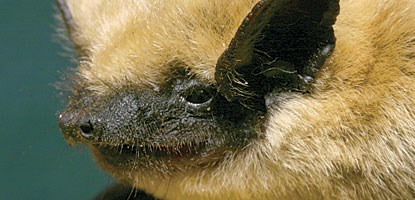
The Inventory and Monitoring program at Canyonlands conducted a two-year bat inventory which yielded a wealth of information about this little-known and often underappreciated group of animals. Dr. Mike Bogan of the U.S. Geological Survey in Albuquerque, together with his colleague, Dr. Tony Mollhagen, confirmed the presence of 16 native bat species in the park. Previous studies confirmed only eight species. As a comparison, only 18 bat species have been documented in the state of Utah. The ‘bat team’ worked at 34 different sites throughout the park and used two different methods to document bats: mist nets and acoustic surveys. The team deployed mist nets near bodies of water and other flyways to capture bats coming to drink or feed on insects, their primary food source. The nets ranged from nine to 60 feet long. One to five nets were set up each evening, depending on the area and shape of the body of water at the sampling site. Nets were erected shortly before sunset and maintained until early morning when bats are most active. The team never left mist nets untended in order to prevent captured bats from being injured. Once a bat was captured, team members recorded the species, sex, reproductive condition, time of capture and descriptive comments about individual animals. Acoustic surveys involve the use of a bat detector which records bat echolocation calls. While bats can see as well as humans, they have a sophisticated method of using sound —echolocation—which enables them to navigate and find food in the dark. Bats produce echolocation by emitting high frequency sound pulses through their mouth or nose and listening to the echo. With this echo, the bat can determine the size, shape and even texture of objects in its environment. Most bat echolocation occurs beyond the range of human hearing. While humans can hear up to 20 kHz (depending on age), bat calls range from 9 kHz to 200 kHz. Scientists have devised methods for eavesdropping on bats with the use of bat detectors. Bat detectors contain ultrasonic microphones that can detect bat echolocation and output the incoming call within the range of human hearing. These electronic signals are recorded and processed to assist in the identification of bat species. For the Canyonlands inventory, bat detectors were positioned at nine sampling sites across the park for one to two nights, either on the ground or attached to a tripod. The detection systems were programmed to record from 30 minutes before sunset to 30 minutes before sunrise. Over the course of the study, the bat team captured and identified 1,717 bats with mist nets. The team released all bats unharmed at their capture site. The maximum catch on a single evening was 134 bats representing 10 species. The average catch per night was 26 bats (four species). The team identified 3,751 recordings with the use of bat detectors, with a total of 11 species. The maximum number of identifiable individual calls recorded during one night was 825, with a species count of nine. The average recordings per night were 250 calls (six species). The study showed that several sites in Canyonlands provide exceptional habitat for bats. Chief among them is Salt Creek Canyon between the junction with Horse Canyon and Peekaboo. A whopping 62% of the total bats captured came from the sampling sites in this area. These sites also yielded high species diversity, suggesting that a variety of species can meet their resource needs along this riparian corridor. No federally listed Threatened or Endangered bats were discovered in Canyonlands. However, the state of Utah lists five of the 16 bat species found as "wildlife species of concern" — species for which there is credible scientific evidence of threats to a population’s continued viability. Although they are long-lived (5 to 20 years), bats are vulnerable because they have low reproductive rates (one "pup" per female per year) and often roost in large groups where disturbances can affect a lot of animals at once. Bats have been maligned in folklore and literature throughout our history. Yet these diverse flying mammals control insect populations, pollinate plants, disperse seeds, and pose little threat to people who do not handle them. Look for bats emerging from their day roosts in Canyonlands at dusk, especially in the spring and summer months. |
Last updated: February 24, 2015
